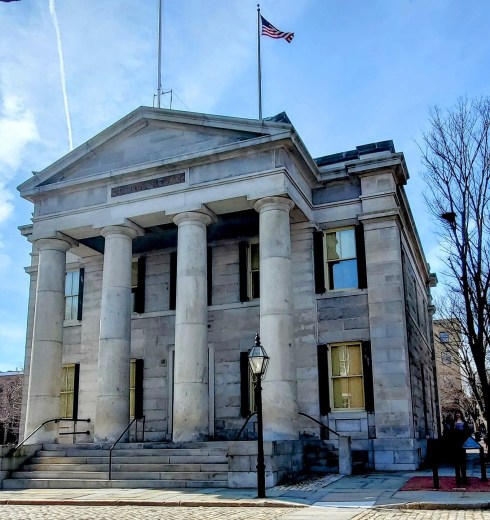One thing that I’ve always loved about Massachusetts is its regional topographical diversity. I’m not sure that this is the correct phrase: topographical generally refers to the natural landscape but I’m referring to the built environment. In nearly every region of Massachusetts, you can explore urban and rural environments adjacent to each other, within the time span of an hour or so. It’s a bit more difficult to get the urban/rural contrast within the general vicinity of Boston, where suburban streetscapes reign, but elsewhere you can explore the architecture of a densely-settled old city by foot in one hour and then find yourself driving amidst farmland in the next. This was my experience over the past few days as I explored the South Coast of Massachusetts, which extends from Cape Cod to Rhode Island along Buzzards Bay. It was my Spring Break breakaway, as I decided to stay relatively close to home rather than taking a big trip. This is beautiful coastline, but if you’re familiar with this blog you know that I’m more interested in human history than the natural world so I tend to explore territory through buildings and this region contains quite an array of architecture. It’s an easy day trip, basically just following Route 6 from Fall River to Wareham or the other way around, but I spent a lot more time in rural New Bedford and rural Dartmouth than I expected to, so I stretched it out to two days. You could do a wonderful Industrial Revolution tour of these region, starting with the Old Slater Mill National Historical Park in nearby Pawtucket, Rhode Island and then proceeding to the powerhouse cities of Fall River and New Bedford where factories remain in various states of redevelopment or decline, but I was a bit more interested in domestic architecture on this trip.
Beginning with the cities, where you can see the impact of all that wealth from whaling (New Bedford) and manufacturing (Fall River AND New Bedford) very clearly, as well as the impact of the DECLINE of these industries. But I was focused on the former! Very impressive mid-nineteenth century houses in both cities: Fall River experienced a fire in 1843 which was followed apparently by a building boom, but both cities have impressive revival buildings: Greek, Gothic, even Renaissance. I stayed away from everything relating to the notorious Lizzie Borden in Fall River for the same reason I don’t dwell on anything related to 1692 here: I’m not interested in the commercial exploitation of tragedy. In New Bedford, I breezed through the Whaling Museum too quickly: that definitely deserves its own post and both cities (of course) have active historical societies that document and exhibit their economic and social histories.
Great Gothic Revivals! This regional ramble was prompted by my desire to see just one house, the William J. Rotch cottage in New Bedford (first up below), and it has some impressive neighbors.







This last red house is in Fall River; all the rest are in New Bedford, in the immediate vicinity of the Rotch Cottage.
Great Greek Revivals!
In both cities—-more institutional than residential I think, although some larger buildings began as residences and then became offices or institutions. The first house below is another Rotch house in New Bedford with a lovely adjacent garden, now a museum, and the following houses are also in New Bedford except for the last two, which are in nearby Mattapoisett: rural variations on a theme.






I didn’t expect Fall River to remind me of…….San Francisco? The Highlands Historic District looks WAY down on the Taunton River and Mount Hope Bay. I couldn’t really capture this in pictures, but here are a few houses in the district.




Idiosyncratic Buildings: The former Durfee High School/current Probate Court building in Fall River & the Seamen’s Bethel in New Bedford.


Cape-Towns: the South Coast is very close to Cape Cod and thus very Cape-like, although less commercial. And all manner of Capes can be found all along Buzzards Bay, particularly east of New Bedford. I think this first one is in Westport (although I can’t quite remember, was in a bit of a daze at the time), and the following photographs are of Mattapoisett (2) and Marion (2).





Shingles: South of Boston you tend to see more shingles than clapboards on older houses, but there were some interesting shingle-clapboard combinations on the South Coast as well. Below: Westport (2), the lovely Dartmouth village of Padanaram (2), Marion (2), and the sign on the Rochester Women’s Club.







A working Coast, past and present: Outside of the cities, you can see evidence of work past and present: in the harbors, of course, but also on the land. The Russells Mills section of Dartmouth (which is one of the largest Massachusetts towns in terms of acreage) is preserved as an early center of rural industry, as is the Tremont Nail Factory District in Wareham, and there are “Right to Farm” signs in nearly all the towns I visited, and of course, cranberry bogs! Below: Russells Mills (2), Padanaram Harbor, and Wareham (2).





Some Orientation: Crop of the South Coast from Ernest Dudley Chase’s 1964 tourism map of Massachusetts, Boston Public Library; an old sign in Rochester.







